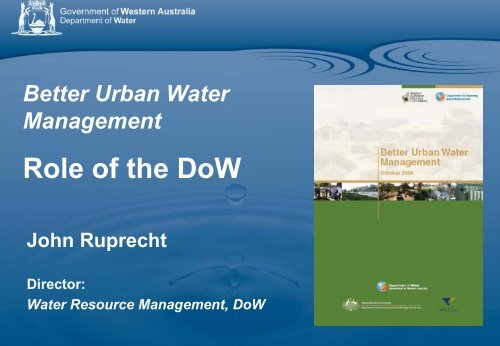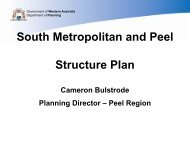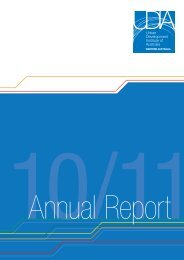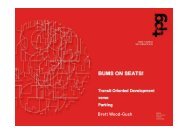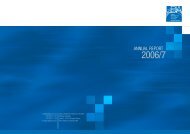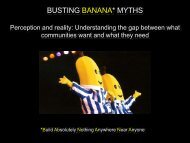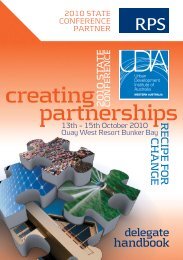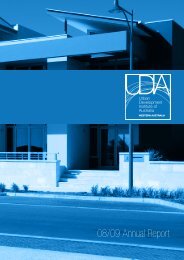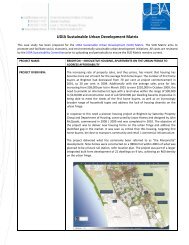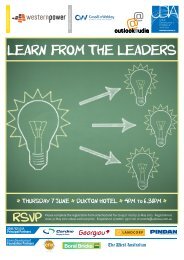Better Urban Water Management - Urban Development Institute of ...
Better Urban Water Management - Urban Development Institute of ...
Better Urban Water Management - Urban Development Institute of ...
Create successful ePaper yourself
Turn your PDF publications into a flip-book with our unique Google optimized e-Paper software.
<strong>Better</strong> <strong>Urban</strong> <strong>Water</strong><br />
<strong>Management</strong><br />
Role <strong>of</strong> the DoW<br />
John Ruprecht<br />
Director:<br />
<strong>Water</strong> Resource <strong>Management</strong>, DoW
Integrated land & water planning<br />
“<strong>Water</strong> Planning should inform and integrate with land<br />
use planning. Increasingly, it is intended that water<br />
planning should precede land use planning. This will<br />
not only provide an important natural resource<br />
management context for land planning, but will identify<br />
resource opportunities, constraints and incompatible<br />
land use activities”<br />
State <strong>Water</strong> Plan (Government <strong>of</strong> WA, 2007)
<strong>Water</strong> Planning Framework<br />
<strong>Urban</strong> Drainage and <strong>Water</strong> <strong>Management</strong> Planning<br />
Vision:<br />
Purpose:<br />
Highest and best use <strong>of</strong> water resources<br />
to ensure the states water resources are<br />
planned and managed to meet<br />
community requirements now and into<br />
the future (DoW strategic plan, 2007)
DoW role in BUWM<br />
• Provide technical water resource<br />
management advice for the state.<br />
• Recommend information<br />
requirements for proposals.<br />
• Liaise with stake holders (state gov,<br />
LGA’s, consultants, developers etc.) on<br />
water management issues including<br />
training and capacity building.<br />
• Assess water management<br />
strategies/plans and advice DMA if<br />
these are satisfactory.<br />
• Provide technical information and<br />
spatial data to assist planning (i.e.<br />
flood management, GW levels).
Regional Planning<br />
• South West (draft)<br />
• Perth-Peel<br />
• Pilbara (Draft)<br />
• Great Southern –<br />
Albany Hinterland<br />
• Kimberley<br />
• Mid West (in process)<br />
Guidance Documents<br />
DWMP’s<br />
Complete:<br />
Byford<br />
Swan Growth Corridor<br />
Southern River<br />
Forrestdale<br />
In preparation:<br />
Jandakot<br />
Murray<br />
Mundijong / Whitby -<br />
DWMS<br />
Keralup - DWMS<br />
Wanneroo - DWMS<br />
Technical Guidance/Guidlines<br />
- CGL/AGL (in prep)<br />
- Monitoring (pre & post)<br />
guidance (in prep)<br />
LWMS<br />
Guidelines<br />
interim<br />
available<br />
UWMP Guidelines<br />
available<br />
Stormwater <strong>Management</strong><br />
Manual for WA<br />
available<br />
Decision Process for Stormwater<br />
<strong>Management</strong> in WA<br />
available<br />
DoW position statement on<br />
implementation <strong>of</strong> framework<br />
- DoW role, implementation rules,<br />
level <strong>of</strong> detail, time frames.
Drainage and <strong>Water</strong> <strong>Management</strong> Planning<br />
DWMPs<br />
Complete:<br />
Byford<br />
Swan Growth Corridor<br />
Southern River<br />
Forrestdale<br />
In preparation:<br />
Jandakot<br />
Murray<br />
In addition:<br />
Mundijong / Whitby - DWMS<br />
Keralup - DWMS<br />
Wanneroo - DWMS
<strong>Urban</strong> Drainage Planning<br />
Why do a DWMP<br />
• Protect from flood and inundation<br />
• Protect environmental assets<br />
• ID opportunities for water conservation and fit<br />
for purpose use<br />
What’s in a DWMP<br />
• Stormwater and groundwater management<br />
strategies, incl. flow paths, flow rates, levels<br />
• WSUD principles and BMPs<br />
• <strong>Water</strong> quantity and quality targets<br />
• Contains pre-development hydrology (post<br />
development in areas where planning has<br />
already occurred)
BUWM Implementation
BUWM Implementation<br />
Principles for application<br />
– Informed decision making<br />
– Early communication between all<br />
parties (prelim. review prior to<br />
advertising)<br />
– Information relevant to the decision<br />
being made (ie planning stage)<br />
– Size <strong>of</strong> document relates to level <strong>of</strong><br />
WRM risk on site<br />
Flexibility<br />
– Land already zoned<br />
– Small/urban infill developments
BUWM Implementation<br />
Which BUWM report <br />
• 2 questions to determine<br />
a) What is the planning level and urban<br />
water management question.<br />
b) What is the next planning level and<br />
urban water management question.<br />
During<br />
storm<br />
Size/Detail <strong>of</strong> Reports (Risk Table)<br />
• Vary depending on the water resource<br />
constraints <strong>of</strong> the site and the level <strong>of</strong> risk<br />
posed by the proposal.<br />
1 Day<br />
after<br />
storm
BUWM Implementation<br />
Information from Table 3, Page 12 (BUWM, WAPC 08)<br />
Level <strong>of</strong> planning and urban water<br />
management question<br />
Regional level planning<br />
What are likely areas for land use change<br />
in the future that impact the use and<br />
<strong>Management</strong> <strong>of</strong> water resources<br />
District level planning<br />
Is this area capable <strong>of</strong> supporting <strong>Urban</strong><br />
development and if so, what areas are<br />
required for water management<br />
Local level planning<br />
How will the proposed urban structure<br />
address water use and management<br />
Subdivision<br />
How will the final urban form use and<br />
manage water<br />
<strong>Water</strong> management report and purpose<br />
Regional <strong>Water</strong> <strong>Management</strong> Strategy (RWMS)<br />
• Identifies areas for future land use change and potential<br />
WRM impacts<br />
District <strong>Water</strong> <strong>Management</strong> Strategy (DWMS)<br />
• Demonstrates area is capable <strong>of</strong> supporting urban<br />
development and identifies land areas required for water<br />
management.<br />
Local <strong>Water</strong> <strong>Management</strong> Strategy (LWMS)<br />
• Demonstrates how urban structure will addresses water<br />
use & management and identifies existing and required<br />
water management infrastructure including detailed land<br />
requirements<br />
<strong>Urban</strong> <strong>Water</strong> <strong>Management</strong> Plan (UWMP)<br />
• Demonstrates how the proposal complies with LWMS and<br />
how the final urban form/infrastructure will use and<br />
manage water
- Site<br />
- -On<br />
Extent <strong>of</strong> information required<br />
Risk<br />
Site conditions<br />
Information Requirements<br />
Low<br />
Medium<br />
High<br />
- Depth to groundwater (> 3m)<br />
- Infiltrate on site<br />
- No <strong>of</strong>fsite discharge or regional drainage<br />
issues<br />
- Depth to groundwater ( between 3 and<br />
1.2m)<br />
- Offsite discharge to local &/or regional<br />
system;<br />
- No regional bushland or significant wetland<br />
issues (ie MU or RE);<br />
- Medium ASS risk<br />
- Depth to groundwater (< than 1.2 m);<br />
- Proposed <strong>of</strong>f-site drainage with potential<br />
adverse impacts to wetlands/waterways;<br />
- Contains a floodplain;<br />
- Known contaminated site;<br />
- High ASS risk; or<br />
- Contains any part <strong>of</strong> CCW or its buffer.<br />
Minimum<br />
- Demonstrate that planning will be consistent<br />
with SPP 2.9 and the Stormwater<br />
<strong>Management</strong> Manual <strong>of</strong> WA.<br />
Limited<br />
assessment to determine management<br />
responses in terms <strong>of</strong> the surrounding<br />
(sub)catchment;<br />
site monitoring and demonstration <strong>of</strong><br />
representative sampling (to be agreed with<br />
DoW)<br />
• Comprehensive<br />
•- detailed modeling and investigations<br />
•- Full BUWM checklist to be addressed in<br />
detail
Other Programs<br />
• Capacity Building Program<br />
– LGA’s, DPI, Consultants, developers etc.<br />
– New <strong>Water</strong>ways<br />
• Research & <strong>Development</strong> Program<br />
– Demonstration projects<br />
– trial <strong>of</strong> BMP’s in WA<br />
• Decision assessment tools<br />
– LG toolbox (policy, guidance, statutory<br />
mechanisms, incentives)<br />
– MUSIC for some catchments<br />
– Further guidance documents
DoW Planning/Guidance documents<br />
<strong>Better</strong> <strong>Urban</strong> <strong>Water</strong><br />
<strong>Management</strong>:<br />
Department <strong>of</strong> <strong>Water</strong><br />
Position Statement
Key guidance<br />
• State Planning Policy 2.9: <strong>Water</strong> Resources (2006)<br />
• <strong>Better</strong> <strong>Urban</strong> <strong>Water</strong> <strong>Management</strong> (WAPC, 2008)<br />
• Planning Bulletin 92: <strong>Urban</strong> <strong>Water</strong> <strong>Management</strong><br />
(WAPC, 2008)<br />
• <strong>Water</strong> Quality Improvement Plans – Peel-Harvey, Swan-Canning, Vasse-<br />
Geographe<br />
• Various Drainage and <strong>Water</strong> <strong>Management</strong> Plans<br />
(DoW, in prep)<br />
• <strong>Urban</strong> water management plans: guidelines for preparation (DoW, 2008)<br />
• Developing A Local <strong>Water</strong> <strong>Management</strong> Strategy<br />
(DoW, in publication)<br />
• Liveable Neighbourhoods Edition 4 (WAPC, 2007)<br />
• Developing alternative water supplies in the Perth Metropolitan area series<br />
(<strong>Water</strong> Corporation, 2008)<br />
• Guidelines for the use <strong>of</strong> MUSIC on the Swan Coastal Plain (DoW, in prep)<br />
• Peel-Harvey WSUD Technical Guidelines (PC, 2006)<br />
• Stormwater <strong>Management</strong> Manual for Western Australia (DoW 2004 – 2007)
DoW Planning/Guidance documents<br />
<strong>Better</strong> <strong>Urban</strong> <strong>Water</strong><br />
<strong>Management</strong>:<br />
Department <strong>of</strong> <strong>Water</strong><br />
Position Statement
Thank you for your time<br />
Questions
Sub - Regional Planning<br />
Document<br />
Who<br />
Purpose<br />
Contents<br />
Regional/ subregional water management strategy<br />
• WAPC/State Govt<br />
• Informed by DoW Regional <strong>Water</strong> Plan<br />
• Supports sub-regional strategy<br />
• Identifies areas for future land use change and potential WRM<br />
impacts<br />
• Principles, objectives & targets<br />
• <strong>Water</strong> balance to guide resource needs <strong>of</strong> environment<br />
• <strong>Water</strong> source planning for existing & future development<br />
• Fit-for-purpose water uses and infrastructure, regional surface and<br />
groundwater conditions<br />
• Mapping <strong>of</strong> catchments, water dependent ecosystems<br />
• Historical land use<br />
• Identify future actions required and responsibilities
District Planning<br />
Document<br />
Who<br />
Purpose<br />
Contents<br />
District <strong>Water</strong> <strong>Management</strong> Strategy (DWMS)<br />
• Developer on behalf <strong>of</strong> WAPC/LGA (approved by WAPC on advice from<br />
DoW)<br />
• Informed by DoW Drainage and <strong>Water</strong> <strong>Management</strong> Plan (DWMP)<br />
• Supports District Structure Plan, Region Scheme Amendment, Local<br />
Planning Strategy<br />
• Demonstrates area is capable <strong>of</strong> supporting urban development and<br />
identifies land areas required for water management.<br />
• Catchment objectives, targets & principles,<br />
• Catchment water balance<br />
• Surface and groundwater flows, levels and quality<br />
• Mapping <strong>of</strong> catchments & environmental assets/water dependant<br />
ecosystems<br />
• Existing/past LU (potential for contamination)<br />
• Conceptual LU plan including multiple use corridors– assessment <strong>of</strong> impacts<br />
• Sources for drinking water and other uses (fit-for-purpose)<br />
• Arterial drainage strategy - 100yr flood paths, required detention storages,<br />
groundwater levels & fill<br />
• Identify issues to be addressed at later stages (roles, funding)
Local Planning<br />
Document<br />
Who<br />
Purpose<br />
Contents<br />
Local <strong>Water</strong> <strong>Management</strong> Strategy (LWMS)<br />
• Developer on behalf <strong>of</strong> Local government (approved by DMA on advice from<br />
DoW)<br />
• Informed by DWMS<br />
• Supports LPS Amendment and Local Structure Plan<br />
• Demonstrates how urban structure will addresses water use &<br />
management and identifies existing and required water management<br />
infrastructure including detailed land requirements<br />
• Compliance with Design Objectives<br />
• Conceptual urban water management system (use <strong>of</strong> POS for 1:1 and 1:10<br />
events, flow paths and treatment)<br />
• Site water balance<br />
• Site conditions<br />
• Detailed monitoring and modelling <strong>of</strong> surface water & g/w quality and quantity<br />
• Fit-for-purpose water use strategy<br />
• Suite <strong>of</strong> BMPs e.g. median swales, bioretention, side entry pits<br />
• Pre & post development monitoring framework<br />
• Requirements for subdivision (UWMP)
Subdivision<br />
Document<br />
Who<br />
Purpose<br />
Contents<br />
<strong>Urban</strong> <strong>Water</strong> <strong>Management</strong> Plan (UWMP)<br />
• Proponent (approved by WAPC on advice from DoW)<br />
• Informed by LWMS -<br />
• Supports subdivision proposal<br />
• Demonstrates how the proposal complies with LWMS and how the final<br />
urban form/infrastructure will use and manage water<br />
• Demonstrated compliance with Design Objectives<br />
• Further modeling <strong>of</strong> groundwater & surface water systems<br />
• Further ASS/ contamination assessment where required<br />
• Specific BMPs and design <strong>of</strong> water management system including stormwater<br />
• <strong>Management</strong> <strong>of</strong> subdivisional and construction works<br />
• Monitoring and maintenance arrangements<br />
• Roles, responsibilities and funding
Subdivision Conditions<br />
• If you DON’T have an approved LWMS AND there are NO water issues<br />
on site<br />
– Submit Subdivision proposal<br />
– Condition will be set: TYPE 1 drainage system designed and constructed<br />
consistent with stormwater management manual. (LGA to clear)<br />
• IF you have approved LWMS:<br />
– Submit Subdivision proposal<br />
– Condition will be set: TYPE 2 UWMP PRIOR to commencement <strong>of</strong><br />
groundbreaking activities consistent with regional, district or LWMS etc (DoW to<br />
clear)<br />
• If you DON’T have an approved LWMS AND there are WATER ISSUES<br />
ON SITE<br />
– Submit Subdivision proposal WITH initial UWMP<br />
– Condition will be set: TYPE 3 UWMP PRIOR to commencement <strong>of</strong><br />
groundbreaking activities consistent with Stormwater Mgt manual (DoW clears)<br />
• All <strong>of</strong> the above will have a implementation condition:<br />
– The approved UWMP shall be implemented by the land owner, to the satisfaction<br />
<strong>of</strong> the Western Australian Planning Commission on the advice <strong>of</strong> the local<br />
government. (Local government)
BUWM: Fast-track*<br />
assessment proposal<br />
Definitions:<br />
Fast track<br />
Advanced draft<br />
Major proposal<br />
Response within 10 working days<br />
All DoW issues demonstrated by proponent to<br />
have been addressed<br />
Will be defined via government approval<br />
process reviews<br />
Criteria:<br />
Proposal identified by government as “major proposal”<br />
or<br />
DoW determines that proposed documentation is at advanced<br />
draft** stage
FAST TRACK Process : Proposal<br />
for discussion<br />
1-2<br />
weeks<br />
2-4<br />
weeks*<br />
4-6<br />
weeks<br />
Preliminary assessment: (within 2 weeks) check<br />
against BUWM checklist – notify proponent if information<br />
inadequate, sendback with checklist (2 nd sendback<br />
needs stakeholder meeting.<br />
Technical assessment*: Formulation <strong>of</strong> DoW advice,<br />
identify gaps, complex proposals may require a<br />
stakeholder meeting.<br />
Stakeholder meeting: To clarify/agree on a way<br />
forward for any issues <strong>of</strong> debate, clearly identify topics<br />
for discussion in advance, bring support data<br />
Advanced draft / fast track: (within 2 weeks)<br />
Final check against checklist/DoW comments –<br />
proponent must include summary <strong>of</strong> DoW<br />
comments addressed and identify location in<br />
document


